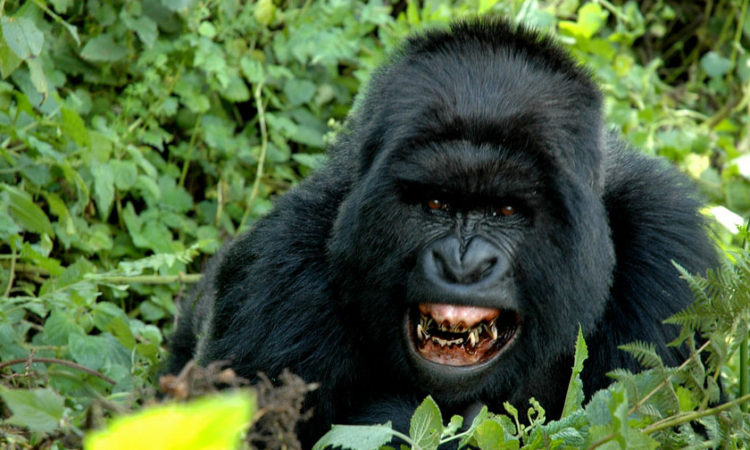How Do Mountain Gorillas Communicate With Each Other?
How Do Mountain Gorillas Communicate With Each Other?: Like humans, mountain gorillas are calm, kind animals with a range of emotions. In general, gorillas use all of their antics and behaviors as a way to communicate. Only found in certain areas of Rwanda and Uganda, mountain gorillas are a subspecies of eastern gorillas. Here are some specifics regarding the behavior of these fascinating social creatures.

The largest primates still alive, gorillas inhabit the jungles of West Africa and Central-East Africa. The eastern gorilla and the western gorilla are two distinct species. The Eastern subspecies includes mountain gorillas.
Only a few regions of Africa are home to mountain gorillas, which are endangered. In Virunga National Park, Volcanoes National Park, and Mgahinga National Park, they are primarily found in the vicinity of the Virunga Mountains, a range of extinct volcanoes that border Rwanda, Uganda, and the Democratic Republic of the Congo, respectively. The remainder can be found in Uganda’s Bwindi Impenetrable National Park.
Highlights of the Population of Mountain Gorillas The only ape population in the world to have grown over time is the over 1000 mountain gorillas. According to the IUCN Red List, this category is endangered. Standing on two feet, height: 4 to 5 ½ feet. Weight: 440 pounds or more.
What is special about mountain gorillas?
Mountain gorillas reside in forested highlands between 8,000 and 13,000 feet above sea level, as their name implies. Because of their thicker, longer fur, these mountain gorillas are able to withstand extremely cold temperatures.
Compared to other gorilla species, mountain gorillas have wider chests and longer faces.
It wasn’t until renowned American primatologist Dian Fossey made mountain gorilla trekking well-known in the west that it became a safari attraction. For eighteen years, she observed their behavior and conducted in-depth research on them.
What Makes Mountain Gorillas Talk?
The fact that humans and gorillas share almost 98% of their DNA is the most fascinating truth about them. They are therefore humankind’s closest cousins. They are therefore vulnerable to a range of human emotions, including joy and melancholy.
Indeed, they are unable to speak like humans, but they may still communicate by body language, vocalizations, and facial expressions, among other means.
High heights and lush forests are the feeding grounds for mountain gorillas. It is difficult for them to locate one another here. As a result, they use sounds to locate one another or alert other gorillas to potential threats.
Communication Techniques
There are several ways that mountain gorillas can communicate, as listed below:
Vocalizations: The fact that mountain gorillas employ 25 different visualization tones astounds visitors arriving for Gorilla Safaris. The Silverbacks gorillas who are the group leaders are known to speak the loudest. The following lists a few vocalization tones:
Barking and Grunting: Mountain gorillas are known to bark and grunt primarily when they are traveling. Because they go through dense forests, gorillas need to be able to make these noises in order to communicate with one another.
In gorilla groups, grunts and barks are employed for socialization, particularly when discipline is needed.
Screams and roars: Silverbacks typically use roars and screams as warning or alarm signals.
In what ways do mountain gorillas exchange messages with one another?
Belches: The rumbling belching sounds are one of the most common ways that mountain gorillas communicate. The mountain gorillas utilize this to express their sense of contentment.
Typically, infant gorillas would whimper, howl, and scream. When babies try to communicate their needs to their moms, they will whimper, cry, or scream.
Mountain gorillas that have discovered their favorite food will either hum or sing when they are happy. A family of gorillas can even sing or hum together.
Facial Expressions: A mountain gorilla’s facial expressions reflect its feelings. By observing its face, you can determine its mood. Gorillas use a variety of facial expressions, including as play faces, smiles, and yawning.
The term “play face” describes a mountain gorilla’s visage when its mouth is open and its lower lip hangs down. The teeth are also hidden. Juveniles frequently exhibit this expression, which is the most prevalent.
For gorillas, play face genuinely evokes laughing.
Smiling is another way that mountain gorillas express themselves. Appeasement or acquiescence is conveyed by smiling. The first is when their mouth is open and both rows of teeth are clearly visible.
Yawning is a warning indication and typically indicates masculine dominance. When agitated or nervous, male mountain gorillas yawn.
The most recognizable gesture associated with mountain gorillas is chest thumping. Large air sacs are found in the chests of gorillas. They make a long-range sound when they beat their chests with cupped fists. When they are going to attack another gorilla, they frequently do this. The leaders of the organizations known as Silverbacks typically carry out this task. To demonstrate their strength and frighten others, they beat their chest and thud the ground.
Body Postures: Silverbacks occasionally tighten their stance to let other group members know they’re unhappy. This tense position makes their chests look larger and more menacing. Additionally, when they feel threatened, they enlarge their chest to appear large and menacing. To express their emotions and desire to their lovers, these ground-dwelling apes use various body postures.
Are humans able to communicate with mountain gorillas?
Mountain gorillas mostly use gestures and sign language to interact with people. According to research, mountain gorillas are amiable and similar to us. But human diseases can affect mountain gorillas. Therefore, it is recommended that you keep your distance from them while you go mountain gorilla trekking.
In conclusion, mountain gorillas are sentient animals that communicate through a variety of senses, such as sight, sound, smell, and touch. They communicate verbally and nonverbally and reside in social groups.



